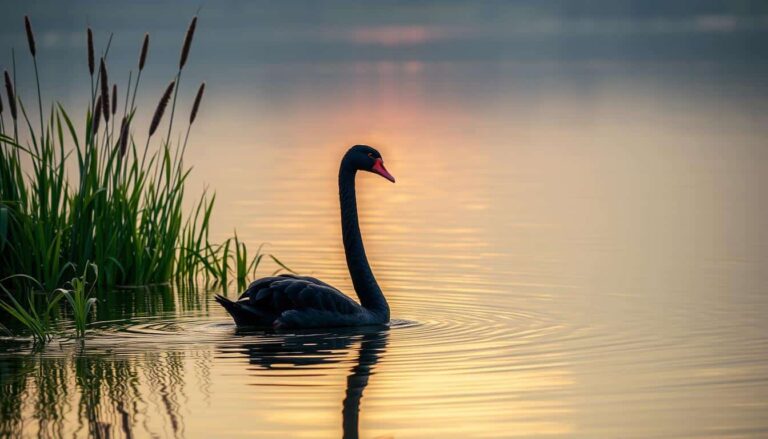10 Species of Backyard Birds in Hawaii (With Pictures)
Ever thought about the birds you could see in your backyard in Hawaii? With over 300 bird species, including 60 unique to Hawaii, the islands are a bird lover’s dream. But which birds might visit your yard? Let’s look at the 15 most common backyard birds in Hawaii and their special traits.
We’re thrilled to share our knowledge of Hawaii’s vibrant bird life. From the tiny Warbling White-eye to the eye-catching Red-crested Cardinal, these 15 species will amaze anyone. Let’s explore the world of Hawaii’s backyard birds together!
Backyard Birds in Hawaii
In Hawaii, birdwatchers often see many different birds in their backyards. Most of these birds live in forests and mountains far from us. But, the birds we see every day are ones that came from somewhere else or changed to live in cities.
These Common Backyard Birds in Hawaii have really made the islands their home. They’re a big part of our daily lives now
1. Zebra Dove
- Wingspan: 24 to 26 cm
- Length: 20 to 23 cm
- Mass: 40 to 60 g
- Lifespan: 14 years
The Zebra Dove (Geopelia striata), also known as the Common Dove, is a common bird in Hawaii’s backyards and parks. It came from Southeast Asia in 1922 and quickly spread, becoming a top bird species in the state.
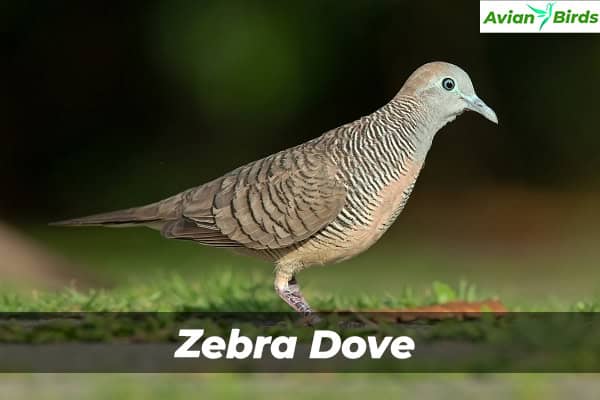
Zebra Doves stand about 8 inches (20 cm) tall. They have a white-tipped tail and a blue-grey face. Their belly and sides are cinnamon-colored with black bars. You can see them in parks, restaurants, and homes, looking for food on the ground.
These birds are great at adapting and surviving. They can have up to five broods a year, which means lots of babies. They eat grass, seeds, and small bugs, and even food scraps from people.
Even though Zebra Doves are not endangered, they can be a problem in Hawaii. They can spread avian malaria, which is deadly for many native birds. Yet, they are still a common and beloved bird in Hawaii, showing how well they’ve adapted..
2. House Sparrow
- Wingspan: 19 to 25 cm
- Length: 14 to 16 cm
- Mass: 25 to 32 g
- Lifespan: 13 years
The House Sparrow (Passer domesticus) is a common bird in Hawaii, part of the Passeridae family. It was brought to the islands in the 1870s and has thrived in cities and suburbs. With over 500 million worldwide, it’s a successful invasive bird in Hawaii.

Male House Sparrows have a grey crown, black mask, and a black bib. They also have a rufous back and wings. Females look less flashy. These birds live in many places, not just forests or tundra. You can find them in farms, cities, villages, and towns across Hawaii.
One big worry is how they push native birds out by taking over their homes and food. They breed a lot, all year, making things worse. They take over nests and food from other birds.
House Sparrows eat seeds, grains, and sometimes insects. This lets them live in many places. But, they can damage buildings by nesting there. Their droppings can also make food unsafe to eat.
3. Java Sparrow
- Wingspan: 21 to 23 cm
- Length: 13 to 15 cm
- Mass: 20 to 25 g
- Lifespan: 10 years
The Java Sparrow, also known as the Padda oryzivora, was brought to Hawaii in the 1960s. It’s a large, colorful finch with a bluish-grey body and white cheeks. Now, it’s often seen in Hawaii’s lowlands, especially in Honolulu’s parks and neighborhoods.

Courtship and Breeding
The Java Sparrow’s courtship is quite a show. Males sing and dance to attract females. They use dry grass to build nests in trees, buildings, or bushes. Females lay up to eight eggs, which take 13 to 15 days to hatch.
4. Spotted Dove
- Wingspan: 43 to 48 cm
- Length: 28 to 32 cm
- Mass: 150 to 160 g
- Lifespan: 8 years
The Spotted Dove, or Spilopelia chinensis, is a common bird in Hawaii’s backyards. It came to the islands in the 1800s from Southeast Asia. Now, it lives alongside Zebra Doves and native pigeons.
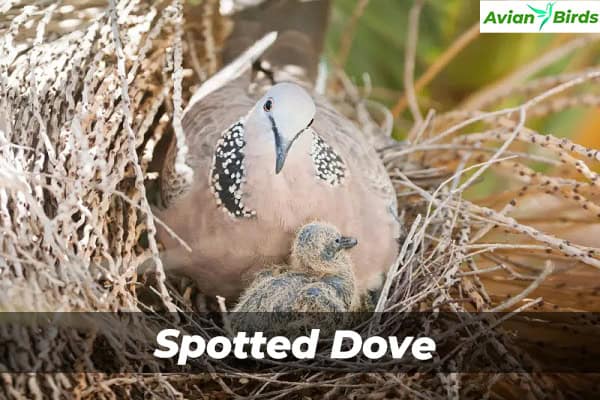
This dove has brownish-grey feathers and a big white-tipped tail. Its standout feature is a black, white-spotted band on its neck. It also has a rosy breast and a greyish belly. In Hawaii, Spotted Doves breed all year, but most in September to January.
Their courtship is quite a sight. The male flies high, opens his wings and tail, and swoops down to a perch near the female. He claps his wings before diving. This behavior shows how the Spotted Dove has become a key part of Hawaii’s bird life.
5. Red-whiskered Bulbul
- Wingspan: 25 to 28 cm
- Length: 20 to 22 cm
- Mass: 23 to 42 g
- Lifespan: 4 years
The Red-whiskered Bulbul (Pycnonotus jocosus) is a common bird in Hawaii backyards. It comes from Southeast Asia and was brought to Hawaii. Now, it’s seen often in cities and suburbs. It stands out with its black head, white cheeks, and a red patch under the eye.
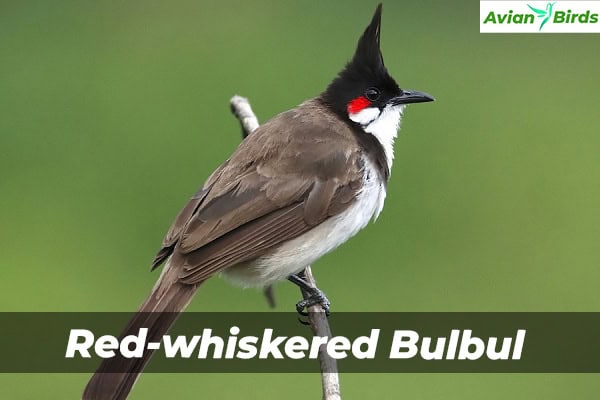
Nesting and Reproduction
Backyard birds In Hawaii, the Red-whiskered Bulbul nests and reproduces like it does in its home region. They build their nests with twigs, grass, and other plant stuff. They put their nests in trees or shrubs.
Female birds lay 2-4 eggs, which take about 14 days to hatch. Both parents take care of the young until they can fly on their own.
This bird is known for its fun behavior and sweet call. It has adjusted well to Hawaii and is now a common bird here. Learning about its nesting and breeding helps us understand this interesting bird better.
6. Common Myna
- Wingspan: 37 to 41 cm
- Length: 23 to 26 cm
- Mass: 82 to 143 g
- Lifespan: 12 years
The Common Myna (Acridotheres tristis), also known as the Indian Myna, is a medium-sized songbird. It’s now a common sight in Hawaii’s cities and farms. Originally from South Asia, it was brought to Hawaii in the 1860s to fight insect pests. It stands out with its shiny black feathers, bright yellow beak, and eye patches.

These birds are known for their loud songs and can imitate many sounds. They eat fruits, insects, and small animals, making them successful in different places. They like to live in cities and gather in big groups, helping them spread across Hawaii.
The Common Myna’s effect on Hawaii’s native birds worries conservationists. As an invasive species, it takes over resources and eats the eggs and young of native birds. This, along with habitat loss and diseases, threatens Hawaii’s unique bird life.
Even though it’s an invasive species, the Common Myna is still seen and heard in many places in Hawaii. Its ability to adapt and breed quickly makes it hard to control. This shows the ongoing struggle to protect Hawaii’s native birds from invasive species.
7. Red-vented Bulbul
- Wingspan: 25 to 28 cm
- Length: 20 to 23 cm
- Mass: 28 to 40 g
- Lifespan: 11 years
The Red-vented Bulbul (Pycnonotus cafer) has arrived in Hawaii. It’s known for its dark brown head, back, and wings, and its white belly and bright red vent. This bird is about 8.5 inches long and comes from the Indian subcontinent. It has settled well in Hawaii.
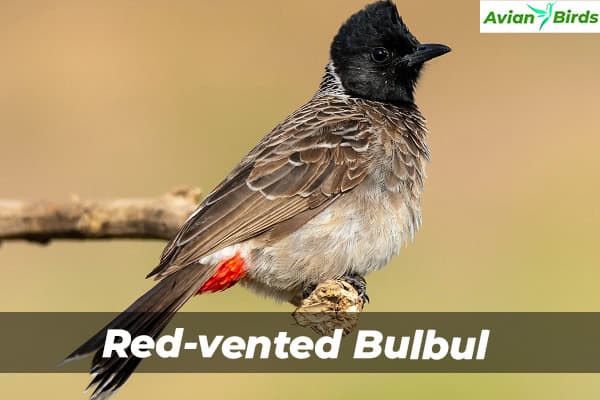
This bird is not found on Kauai but is common on Oahu. People and agencies there need to stop it from moving to other islands. It’s also seen in Mauna Lani on the Big Island and near Hilo. Sadly, it’s an invasive species that has damaged the Oahu orchid industry by over $300,000 in one year.
The Red-vented Bulbul belongs to the Pycnonotus genus, which includes other Bulbul species in Hawaii. These birds are known for their loud calls and live in gardens, parks, and cities. This species was brought to Hawaii as a pet and released in the mid-1950s on Oahu.
If you see a Red-vented Bulbul in Hawaii, tell the authorities. Giving details like where and when you saw it, along with photos or videos, helps track this invasive bird.
8. House Finch
- Wingspan: 20 to 25 cm
- Length: 13 to 14 cm
- Mass: 16 to 27 g
- Lifespan: 11 years
The House Finch is a medium-sized bird that belongs to the finch family. It originally comes from Mexico and the Western United States.
In the 1800s, House Finches were brought from San Francisco to Hawaii, where they now live all over the main islands. They prefer the drier, sunny sides of the islands.

Male House Finches in Hawaii have reddish heads that blend into their throats and chests. Their wings, backs, and bellies are brown with streaks, and their rumps are also red. The shade of red can range from deep red to orange or yellow.
Female House Finches are brown with streaks, similar to males but without the red coloring. Their legs and feet are brown, their bills are horn-colored, and they have black eyes.
Male House Finches sing a warbling song that often ends with a high or low slur. Females don’t sing as much as males and usually produce a simpler version of the male’s song. They both also make a ‘cheep’ sound.
Naturally, House Finches live in open grasslands like savannahs and deserts. But they also do well in places built by people, such as cities, buildings, and lawns. In Hawaii, they can be found everywhere from the coast to the mountains, especially in urban areas.
9. Northern Cardinal
- Wingspan: 25 to 31 cm
- Length: 21 to 23 cm
- Mass: 42 to 48 g
- Lifespan: 15 years
The Northern Cardinal, scientifically known as Cardinalis cardinalis, naturally lives in Mexico, across the eastern United States, and into Southeast Canada.

Introduced to Hawaii in 1929, Northern Cardinals are now common on all the main islands. Their melodious calls are often among the first sounds heard at sunrise.
Male Northern Cardinals are large songbirds in the Cardinal family, known for their beautiful songs. Both males and females sing. Their songs include loud, downward-slurred, or two-parted whistles that end in a trill. The song is often described as ‘cheer, cheer, cheer’ or ‘birdie, birdie, birdie’. They have various other calls, including a clear, metallic chip.
Northern Cardinals have a strong bill, a noticeable crest, and a long tail. The male is strikingly bright red with only a touch of black on its face and throat.
Females are also beautiful, mostly brown with touches of red on the crest, wings, tail, and bill.
10. Red-crested Cardinal
- Wingspan: 25 to 31 cm
- Length: 18 to 20 cm
- Mass: 30 to 35 g
- Lifespan: 13 years
The Red-crested Cardinal, scientifically named Paroaria coronata, is a medium-sized bird that was brought to Hawaii from Brazil in 1930. It is now widespread on all the main islands except the Big Island, where the Yellow-billed Cardinal is more common.
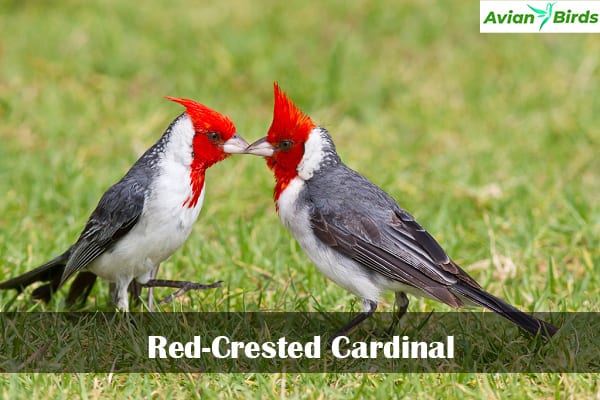
Originally from South America, the Red-crested Cardinal belongs to the Thraupidae family. It has slate-gray upper parts, with a redhead, throat, and crest, and white underparts. It also features a partially white collar, a pale horn-colored bill, and gray legs and feet.
Backyard Birds In Hawaii, the Red-crested Cardinal is known for its musical whistle, often heard in parks and gardens. In its native habitats, it lives in scrublands and forests that have been disturbed. It mainly eats seeds but also consumes small invertebrates.
During the breeding season, male Red-crested Cardinals perform displays by fanning their tails, clicking their beaks, and strutting around. They build bowl-shaped nests using grass, twigs, and animal hair, typically in the fork of a tree.
Check Our Previous Articles:
Wrapping Up…
Hawaii is home to a wide variety of Backyard Birds species, both native and introduced. Many of these birds can only be found in Hawaii. However, the most common birds in backyards and cities are not native but have made Hawaii their home.
These include the Zebra Dove, House Sparrow, Java Sparrow, Spotted Dove, Red-whiskered Bulbul, Common Myna, and Red-vented Bulbul. These birds now make up most of the birds in Hawaii.
It’s important to know about these introduced birds and how they affect native Hawaiian birds. Most of the birds mentioned here are invasive and threaten native species. We must be careful to protect Hawaii’s unique bird life.
Learning about Hawaii’s backyard birds helps us appreciate its rich bird heritage. It also shows how important these birds are to the local environment. Let’s enjoy Hawaii’s birds while also helping to protect its native species for the future.


